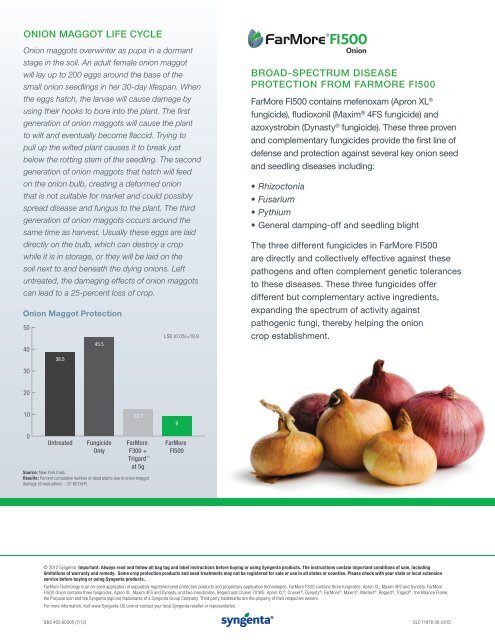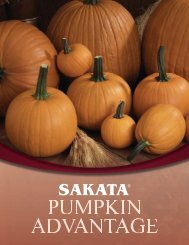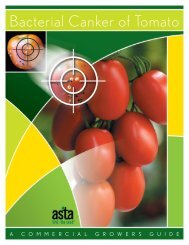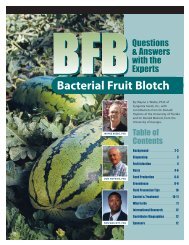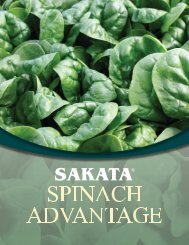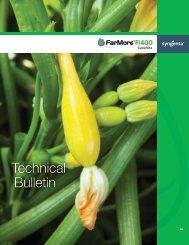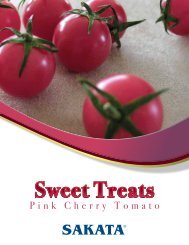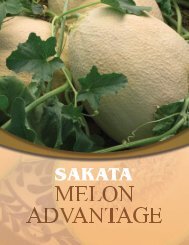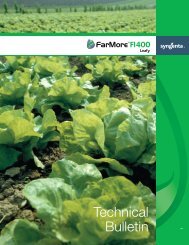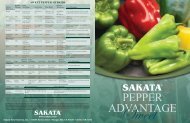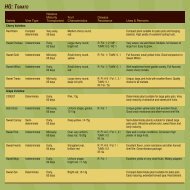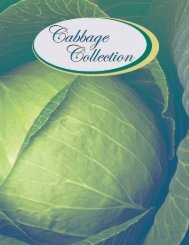FarMore FI500 Onion - Sakata Vegetables
FarMore FI500 Onion - Sakata Vegetables
FarMore FI500 Onion - Sakata Vegetables
Create successful ePaper yourself
Turn your PDF publications into a flip-book with our unique Google optimized e-Paper software.
<strong>Onion</strong> Maggot Life Cycle<strong>Onion</strong> maggots overwinter as pupa in a dormantstage in the soil. An adult female onion maggotwill lay up to 200 eggs around the base of thesmall onion seedlings in her 30-day lifespan. Whenthe eggs hatch, the larvae will cause damage byusing their hooks to bore into the plant. The firstgeneration of onion maggots will cause the plantto wilt and eventually become flaccid. Trying topull up the wilted plant causes it to break justbelow the rotting stem of the seedling. The secondgeneration of onion maggots that hatch will feedon the onion bulb, creating a deformed onionthat is not suitable for market and could possiblyspread disease and fungus to the plant. The thirdgeneration of onion maggots occurs around thesame time as harvest. Usually these eggs are laiddirectly on the bulb, which can destroy a cropwhile it is in storage, or they will be laid on thesoil next to and beneath the dying onions. Leftuntreated, the damaging effects of onion maggotscan lead to a 25-percent loss of crop.<strong>Onion</strong> Maggot Protection50LSD (0.05)=10.945.54038.530Broad-spectrum DiseaseProtection from <strong>FarMore</strong> <strong>FI500</strong><strong>FarMore</strong> <strong>FI500</strong> contains mefenoxam (Apron XL ®fungicide), fludioxonil (Maxim ® 4FS fungicide) andazoxystrobin (Dynasty ® fungicide). These three provenand complementary fungicides provide the first line ofdefense and protection against several key onion seedand seedling diseases including:• Rhizoctonia• Fusarium• Pythium• General damping-off and seedling blightThe three different fungicides in <strong>FarMore</strong> <strong>FI500</strong>are directly and collectively effective against thesepathogens and often complement genetic tolerancesto these diseases. These three fungicides offerdifferent but complementary active ingredients,expanding the spectrum of activity againstpathogenic fungi, thereby helping the onioncrop establishment.201012.390UntreatedFungicideOnly<strong>FarMore</strong>F300 +®Trigardat 5gSource: New York trials.Results: Percent cumulative number of dead plants due to onion maggotdamage (9 evaluations – 37-80 DAP)<strong>FarMore</strong><strong>FI500</strong>© 2012 Syngenta. Important: Always read and follow all bag tag and label instructions before buying or using Syngenta products. The instructions contain important conditions of sale, includinglimitations of warranty and remedy. Some crop protection products and seed treatments may not be registered for sale or use in all states or counties. Please check with your state or local extensionservice before buying or using Syngenta products.<strong>FarMore</strong> Technology is an on-seed application of separately registered seed protection products and proprietary application technologies. <strong>FarMore</strong> F300 contains three fungicides: Apron XL, Maxim 4FS and Dynasty. <strong>FarMore</strong><strong>FI500</strong> <strong>Onion</strong> contains three fungicides, Apron XL, Maxim 4FS and Dynasty, and two insecticides, Regard and Cruiser 70 WS. Apron XL ® , Cruiser ® , Dynasty ® , <strong>FarMore</strong> ® , Maxim ® , Mertect ® , Regard ® , Trigard ® , the Alliance Frame,the Purpose icon and the Syngenta logo are trademarks of a Syngenta Group Company. Third party trademarks are the property of their respective owners.For more information, visit www.Syngenta-US.com or contact your local Syngenta reseller or representative.G&S 402.60305 (7/12) SLC 1187D 06-2012


